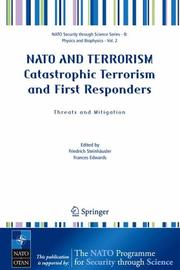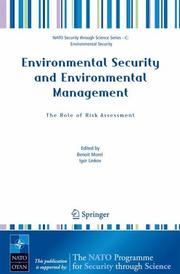| Listing 1 - 2 of 2 |
Sort by
|

ISBN: 9781402035838 1402035837 1402035845 9786610624331 1280624337 1402035853 Year: 2005 Publisher: Dordrecht, Netherlands : Springer,
Abstract | Keywords | Export | Availability | Bookmark
 Loading...
Loading...Choose an application
- Reference Manager
- EndNote
- RefWorks (Direct export to RefWorks)
September 11, 2001 in the U.S., March 11, 2004 in Madrid – just two examples of a series of major terror attacks against NATO member states on both sides of the Atlantic. We now know that international terrorism is capable of transboundary planning and military style execution of attacks, resulting in several thousand dead and wounded. In the future even larger terror attacks can no longer be ruled out, including the deployment of weapons of mass destruction. This new form of catastrophic terrorism poses a major challenge to the first responder community in their search and rescue operations, since these new threats represent an unprecedented risk for their health, possibly even questioning their own survival. Since the first responders are the first line of defence of every community in the aftermath of such a terror attack, it is essential for every community to ensure that its first responders are able to provide their valuable services even in such extreme situations. In this important new book a group of experts represents the current knowledge on the various terrorism threats to first responders resulting from the novel use of conventional weapons, as well radiological, nuclear, biological and chemical weapons. Also, the current situation in selected countries of different sizes and practical experience with terrorism countermeasures (Austria, Israel, Slovenia, Russia, U.S.) is reviewed, focusing on the national operational logistics and the individual needs for improving the present situation. Finally, this book offers innovative solutions to strengthen the level of protection of the first responders, culminating in fifty-one practically applicable recommendations.
Terrorism --- Terrorisme --- Congresses. --- Congrès --- EMERGENCY MANAGEMENT --- CIVIL DEFENSE --- DISASTER RELIEF --- TERRORISM --- Terrorism. --- Safety Management --- Emergency Medical Services --- Disaster Planning --- Environmental Exposure --- Environmental Pollution --- Safety --- Risk Management --- Health Services --- Violence --- Organization and Administration --- Disasters --- Health Care Facilities, Manpower, and Services --- Health Services Administration --- Crime --- Environment --- Public Health --- Accident Prevention --- Social Problems --- Environment and Public Health --- Accidents --- Health Care --- Sociology --- Criminology --- Social Sciences --- Anthropology, Education, Sociology and Social Phenomena --- Social Sciences - General --- Criminology, Penology & Juvenile Delinquency --- Social Welfare & Social Work --- North Atlantic Treaty Organization. --- North Atlantic treaty organisation --- North Atlantic Treaty Organization --- Social sciences. --- Chemistry. --- Medicine. --- Life sciences. --- Physics. --- Social Sciences. --- Social Sciences, general. --- Physics, general. --- Chemistry/Food Science, general. --- Medicine/Public Health, general. --- Life Sciences, general. --- Natural philosophy --- Philosophy, Natural --- Physical sciences --- Dynamics --- Biosciences --- Sciences, Life --- Science --- Clinical sciences --- Medical profession --- Human biology --- Life sciences --- Medical sciences --- Pathology --- Physicians --- Behavioral sciences --- Human sciences --- Sciences, Social --- Social science --- Social studies --- Civilization --- NAVO --- OTAN --- Health Workforce

ISBN: 9781402038914 1402038917 1402038925 9786610461165 1280461160 1402038933 Year: 2006 Publisher: Dordrecht, Netherlands ; London, England : Springer,
Abstract | Keywords | Export | Availability | Bookmark
 Loading...
Loading...Choose an application
- Reference Manager
- EndNote
- RefWorks (Direct export to RefWorks)
The concept of “environmental security” has emerged as one basis for understanding international conflicts. This phrase can mean a variety of things. It can signify security issues stemming from environmental concerns or conflicting needs, or it can mean that the environment is treated as a resource for the long term, and the question is what should be done today to preserve the quality of the environment in the future. In the same way that energy security is about ensuring access to energy for the long run, it can also mean that pressing environmental concerns create a situation where different countries and communities are forced to collaboratively design a unified response, even if cooperation is not generally in the logic of their relations. Over the last several years, the authors of this book and their colleagues have tried to demonstrate the power of risk assessment and decision analysis as valuable tools that decision makers should use for a broad range of environmental problems, including environmental security. Risk analysis is almost more a state of mind or a way of looking at problems than it is a kind of algorithm or a set of recipes. It projects a kind of rationality on problems and forces a certain degree of quantitative rigor, as opposed to the all too common tendency of making environmental recommendations based on anecdotal evidence.
Environmental management --- Environmental risk assessment --- Environnement --- Congresses --- Gestion --- Congrès --- Évaluation du risque --- EnvironnementCongresses --- Environmental management. --- Environmental Sciences --- Earth & Environmental Sciences --- Environment. --- Business. --- Management science. --- Life sciences. --- Ecotoxicology. --- Environmental Management. --- Business and Management, general. --- Life Sciences, general. --- Environmental Monitoring/Analysis. --- Ecotoxicology --- Pollutants --- Pollution --- Environmental health --- Toxicology --- Environmental stewardship --- Stewardship, Environmental --- Environmental sciences --- Management --- Biosciences --- Sciences, Life --- Science --- Quantitative business analysis --- Problem solving --- Operations research --- Statistical decision --- Trade --- Economics --- Commerce --- Industrial management --- Environmental toxicology. --- Monitoring/Environmental Analysis. --- Environmental monitoring. --- Biomonitoring (Ecology) --- Ecological monitoring --- Environmental quality --- Monitoring, Environmental --- Applied ecology --- Environmental engineering --- Measurement --- Monitoring
| Listing 1 - 2 of 2 |
Sort by
|

 Search
Search Feedback
Feedback About UniCat
About UniCat  Help
Help News
News